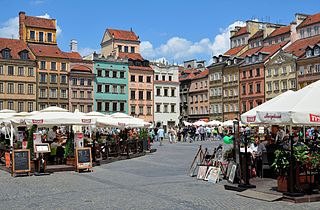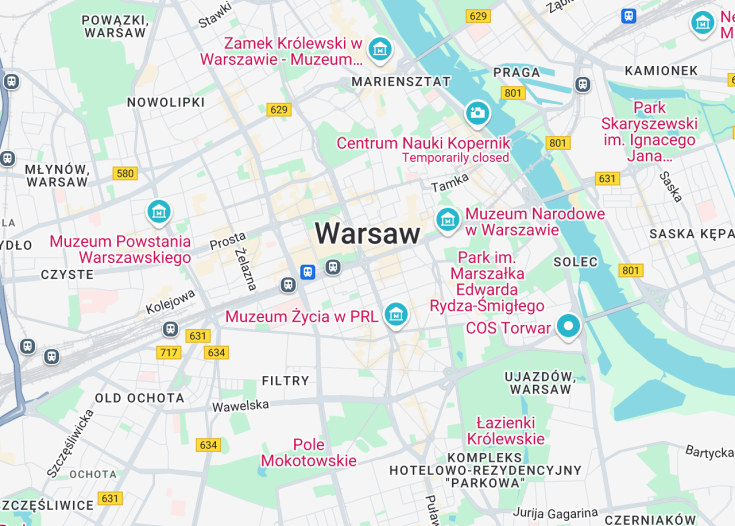Warsaw, Poland’s vibrant capital, seamlessly blends its rich history with modern advancements, painting a breathtaking cityscape. As a cultural hub, it features an array of historical sites, museums, and theaters, harmonized with contemporary architecture and bustling marketplaces. Warsaw’s resilience is profoundly showcased through its meticulously rebuilt Old Town, a UNESCO heritage site, encapsulating centuries of Polish spirit and identity. This city not only offers a journey through the annals of Polish history but also provides a glimpse into its dynamic future, making it a compelling destination for travelers.
Prioritize visiting the Royal Castle and the Wilanów Palace to grasp the full spectrum of Warsaw’s aristocratic past and its architectural grandeur.
Explore Warsaw’s diverse culinary scene which brilliantly mirrors the city’s rich cultural tapestry; be sure not to miss trying traditional dishes like pierogi and bigos.
Top things to do & see in Warsaw
Select the following sights and activities to discover best tickets and tours available in Warsaw.
Warsaw: A Vibrant Gateway to History and Modernity
| Country | Poland |
| Time in Warsaw | GMT+1 |
| Language spoken | Polish |
| Population | 1,790,658 (source: City’s Official Statistics, 2023) |
| Currency | Polish Złoty (PLN, zł) |
| Airports |
|
This 400-word detailed description reveals the rich tapestry of Warsaw, Poland’s capital. Situated on the Vistula River, Warsaw is a phoenix city, famously reborn from the ashes of World War II. Today, it seamlessly mixes historical Gothic and Renaissance buildings with modern glass skyscrapers. At its heart, the meticulously reconstructed Old Town, a UNESCO World Heritage site, captivates visitors with pastel buildings and cobblestone alleys. Warsaw’s resilience is displayed in cultural treasures like the Royal Castle and the Palace of Culture and Science.
The city’s history extends to vibrant contributions in music, being the birthplace of Chopin. It’s also Poland’s political and economic hub, with dynamic cultural scenes and booming businesses. Warsaw is also committed to green spaces, with lush parks and the serene Lazienki Park, where locals and travelers alike retreat. Furthermore, Warsaw is strategically important in Central Europe, influencing European politics and economy, encapsulating a story of triumph and history while sprinting towards a futuristic vision.
Where is Warsaw?
Warsaw is nestled in the east-central part of Poland, standing on the Vistula River, roughly 260 kilometers from the Baltic Sea.
Distances:
| Route | Distance by car | Time by car |
|---|---|---|
| Krakow to Warsaw | 294 km | 4 hours |
| Gdansk to Warsaw | 340 km | 4.5 hours |
| Wroclaw to Warsaw | 347 km | 4 hours 30 minutes |
What is Warsaw famous for?
Warsaw is renowned as a city that has risen from its ashes like a Phoenix, particularly during its extensive rebuilding after World War II. It’s famous for its historical and cultural sites, including the Royal Castle and its association with the composer Frederic Chopin.
History
Before the 14th Century: Early Settlements
Warsaw’s area was initially inhabited by the Vistulan tribes. Evidence suggests that these settlements date back to the 9th and 10th centuries. With its strategic location along the Vistula River, the area began to emerge as a significant trade center.
1300s – 1569: Establishment and Growth
The first historical document acknowledging Warsaw dates from 1313. By the late 13th and early 14th centuries, Warsaw officially became a town. Through strategic marriages and political alliances, it gradually gained more prominence over the following centuries, eventually attracting the attention of the Polish royalty.
1569 – 1795: The Flourishing of the Polish Capital
In 1596, King Sigismund III moved the Polish capital from Krakow to Warsaw due to Warsaw’s more central location. This shift significantly bolstered the city’s importance, ushering in a period of cultural and political prosperity. During this era, the iconic Royal Castle and other significant structures were constructed.
1795 – 1918: Periods of Struggle
Warsaw faced numerous challenges, including three partitions of Poland by Russia, Prussia, and Austria, which erased Poland from the map of Europe. Despite losing its independence, Warsaw experienced rapid industrial growth in the 19th century, even amid oppression.
1918 – 1945: The Wars
Post World War I, Warsaw saw significant reconstruction and modernization but was severely impacted in World War II. The Warsaw Uprising of 1944, an attempt to overthrow German occupation, led to the city’s substantial destruction.
1945 – Present: Rebuilding and Modernization
After the war, Warsaw was practically rebuilt from scratch, championing a mix of restoration of historical buildings and the introduction of socialist realism architecture. Since the fall of communism in 1989, Warsaw has thrived as a dynamic economic center in Central Europe, showcasing a blend of historical and modern architecture and a vibrant cultural scene.
Visit Warsaw
What to see and do in Warsaw, Poland
Warsaw offers an enriching journey through its resilient history and vibrant contemporary culture. Explore the historic Old Town, a UNESCO World Heritage site, rebuilt meticulously after WWII. The Royal Castle and King Sigismund’s Column stand as iconic landmarks. The Warsaw Uprising Museum and POLIN Museum of the History of Polish Jews provide deep historical insights. For art enthusiasts, the National Museum displays vast collections of Polish and international art.
- Stroll through Łazienki Park, especially beautiful during cherry blossom season.
- View the city from the Palace of Culture and Science, offering panoramic views.
- Explore the trendy neighborhoods of Praga and Powiśle.
- Enjoy a Chopin concert in the Royal Łazienki Park during summer Sundays.
Festivals and Events in Warsaw
Warsaw is host to numerous cultural events throughout the year. The Warsaw Film Festival, held annually in October, attracts cinephiles worldwide. The Warsaw Autumn Festival is a prestigious event celebrating contemporary classical music every September. Additionally, the joyful Warsaw Christmas Market from late November to early January brings festive cheer with traditional crafts and foods.
Best time to visit Warsaw
The ideal time to visit Warsaw is late spring (May and June) or early autumn (September and October). These months offer mild weather and lighter crowds, enhancing your experience of the city’s parks, outdoor concerts, and historical sites.
Is Warsaw worth visiting?
Warsaw is decidedly worth visiting for its rich historical tapestry, vibrant cultural scene, and modern attractions. While the city’s stark contrasts between historical and communist-era architecture may not appeal to all, these elements exemplify Warsaw’s unique resilience and transformation. Visitors should be prepared for a range of experiences—from exploring royal history to appreciating the city’s role in modern European culture. Warsaw offers an insightful look into the past and an optimistic glimpse of the future, making it a compelling destination for diverse travelers.
What are the best local dishes to try in Warsaw?
- Pierogi: These are Polish dumplings and perhaps the most famous dish. Fillings vary from meat, cheese, vegetables, to fruit for a sweet version.
- Żurek: A sour rye soup often served with sausage or boiled egg, especially savored during Easter but loved year-round.
- Bigos: Known as Hunter’s Stew, it is a hearty mix of sauerkraut, various cuts of meat and sausages, seasoned with spices.
- Placki ziemniaczane: These are Polish potato pancakes, crispy and often served with sour cream or goulash.
- Gofry: Waffles that are a popular street food sweet treat, usually topped with whipped cream and fruits.
Sampling these dishes at a local “milk bar” – an inexpensive, cafeteria-style eatery – provides an authentic Polish dining experience.
What are the top museums to visit in Warsaw?
- POLIN Museum of the History of Polish Jews: This award-winning museum chronicles the centuries-old history of Jews in Poland.
- The Warsaw Rising Museum: Dedicated to the 1944 uprising, this museum pays tribute to those who fought and died for independent Poland.
- National Museum, Warsaw: It houses a vast range of collections from ancient Egyptian artifacts to modern art.
- Chopin Museum: This museum offers an interactive look at the life and work of Frédéric Chopin, Poland’s most celebrated composer.
Each museum provides an insightful look into different facets of Warsaw’s and Poland’s history and culture.
What are the best parks and nature spots in Warsaw?
- Lazienki Park: Known as the Royal Baths Park, it’s the city’s largest park with a palace, an amphitheater, and freely roaming peacocks.
- Saxon Garden: Opened to the public in the 1720s, this is one of the oldest public gardens in Poland, featuring a baroque fountain and statues.
- Warsaw University Botanical Garden: A lovely spot for plant lovers, housing a variety of flora and providing a peaceful retreat.
- Wilanów Palace Park: This park surrounds the royal Wilanów Palace, featuring gardens in various styles, from English to Chinese.
A walk in any of these areas offers a pleasant escape from the city hustle.
What architecturally significant buildings should I not miss in Warsaw?
- Palace of Culture and Science: A controversial gift from the Soviet Union, this building is a prominent example of Socialist Realism architecture.
- Royal Castle: Reconstructed after its destruction during World War II, it stands as a testament to the resilience of Polish culture.
- Wilanów Palace: Often compared to Versailles, this royal palace combines Baroque architectural styles uniquely adapted to the Polish landscape.
- Modern skyscrapers: Visit the Warsaw Spire or Złota 44 for a glimpse into contemporary, cutting-edge Polish architecture.
These buildings represent a range of eras and styles, illustrating Warsaw’s dynamic architectural history.
Where can I experience live music and nightlife in Warsaw?
- Praga district: Known for its post-industrial spaces, it boasts numerous clubs and bars where live music thrives.
- Pawilony: Behind Nowy Świat Street, this area features a labyrinth of bars, often hosting live bands and DJs.
- Jazz clubs: Check out some renowned jazz spots like Jazzy Buzzy, for a cozy evening of live music.
- Teatr Wielki: Opera enthusiasts will enjoy performances at the National Opera and ballet at this grand theater.
Whether you’re into jazz, rock, electronic music or classical, Warsaw’s live music and nightlife scene has something to offer.
What unique shopping experiences are available in Warsaw?
- Old Town Market Place: Ideal for picking up traditional Polish crafts and souvenirs.
- Nowy Świat Street: One of Warsaw’s most prestigious shopping streets, featuring a mix of international brands and local boutiques.
- Hala Mirowska: A bustling market where you can find everything from fresh produce to local delicacies and crafts.
- Warsaw’s bazaars: Explore Bazar na Kole or Bazar Różyckiego for a range of vintage items, antiques, and collectibles.
These spots offer more than just shopping; they are a taste of local life and culture.
What cultural festivals should I try to attend in Warsaw?
- Warsaw Film Festival: A major autumn event that showcases an international selection of films.
- Chopin and His Europe Festival: Celebrates the life and works of Frédéric Chopin through concerts featuring renowned pianists.
- Warsaw Autumn: This festival is dedicated to contemporary classical music, featuring international composers and performers.
- Jazz na Starówce: A popular summer series of open-air jazz concerts held in the Old Town.
These festivals are ideal for those looking to immerse themselves in cultural activities while visiting Warsaw.
Are there any unique Warsaw-specific experiences I should consider?
- Escape Room “Palace of Culture and Science”: Challenge yourself in an escape room set within Poland’s tallest building, an iconic symbol of Warsaw.
- Vodka Tasting Tour: Discover Poland’s favorite spirit through guided tours that teach you about the history and production process of Polish vodka.
- Milk bar culinary excursion: Experience dining in a milk bar, where you can taste traditional Polish cuisine in a no-frills, communist-era cafeteria setting.
- Chopin Piano Concerts: Attend a concert in Łazienki Park or the Royal Castle, where pianists perform the music of Chopin, giving a sense of the composer’s own world.
These experiences are not just about seeing the city but engaging with it in a distinctively Warsawian way.









